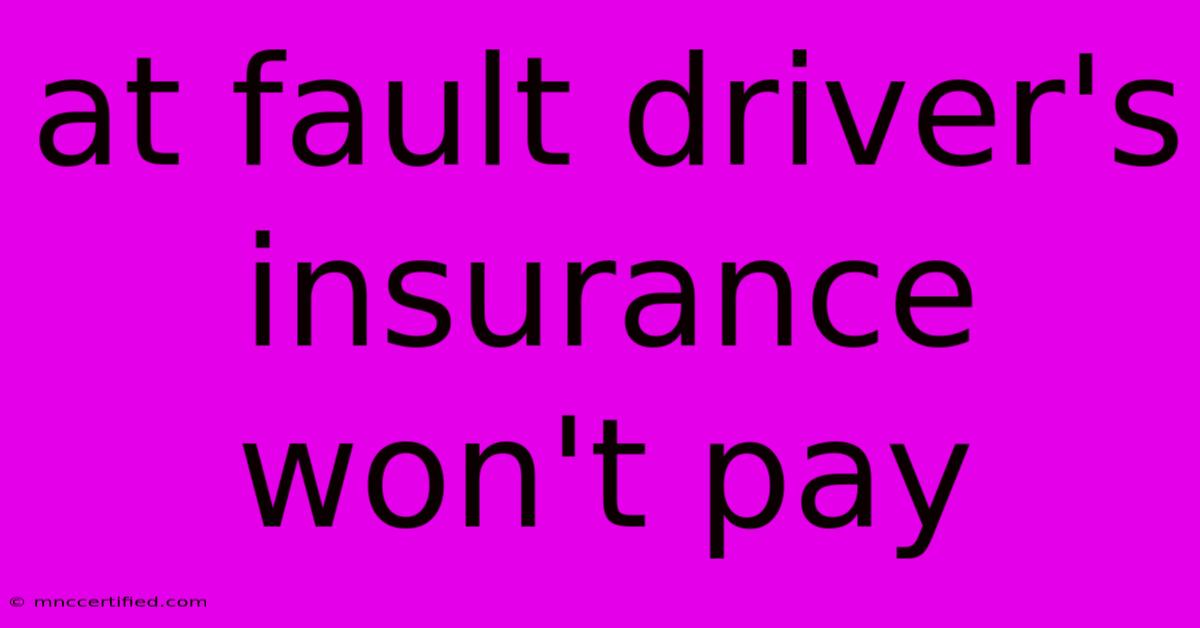At Fault Driver's Insurance Won't Pay

Table of Contents
At Fault Driver's Insurance Won't Pay: What to Do Next
Being in a car accident is stressful enough, but it can be even more frustrating when the at-fault driver's insurance company refuses to pay. This can leave you feeling lost and helpless, wondering how you'll cover the costs of repairs, medical bills, and other expenses. Don't worry, you're not alone. This article will guide you through the steps to take when an at-fault driver's insurance company won't pay.
Understanding Your Rights
Firstly, it's crucial to understand your legal rights. As the injured party, you have the right to pursue compensation from the at-fault driver's insurance company. This is usually done through a process called an insurance claim.
Steps to Take When the Insurance Company Won't Pay
Here's a step-by-step guide to help you navigate this difficult situation:
1. Review Your Policy: Start by carefully reviewing your own car insurance policy. Look for sections related to:
- Uninsured/Underinsured Motorist Coverage: This coverage protects you if the other driver doesn't have enough insurance or no insurance at all.
- Collision Coverage: This coverage helps pay for damages to your vehicle, even if you are at fault.
2. Document Everything: The more documentation you have, the stronger your case. This includes:
- Police report: The accident report provides an official record of the incident.
- Photos and videos: Capture the damage to your vehicle, the scene of the accident, and any injuries.
- Medical records: Gather documentation of any medical treatment you received.
- Repair estimates: Obtain estimates from reputable repair shops for the damage to your vehicle.
- Witness statements: If any witnesses saw the accident, get their contact information and a written statement.
3. Communicate with the Insurance Company:
- File a claim: Make sure you file a claim with the at-fault driver's insurance company as soon as possible.
- Follow up regularly: Stay in touch with the insurance company and keep track of the claim's status.
- Document all communication: Keep records of all phone calls, emails, and letters you exchange with the insurance company.
4. Explore Options:
- Negotiate a settlement: If the insurance company is offering a low settlement, you can negotiate a higher amount based on your losses.
- Consider legal representation: Hiring a lawyer can be beneficial if you can't reach a settlement with the insurance company. A lawyer can:
- File a lawsuit on your behalf.
- Negotiate with the insurance company.
- Represent you in court.
5. Understand Your Options:
- Your own insurance company: If you have uninsured/underinsured motorist coverage, you can file a claim with your own insurance company.
- Small claims court: If you're unable to reach a settlement with the insurance company, you can file a lawsuit in small claims court.
Dealing with Denial
If the insurance company denies your claim, you have the right to appeal their decision. This involves providing additional documentation and arguing your case. If your appeal is also denied, you may need to seek legal counsel.
Preventing Future Problems
To avoid similar situations in the future, consider:
- Increasing your uninsured/underinsured motorist coverage: This ensures you have more financial protection in case the other driver is uninsured or underinsured.
- Maintaining a good driving record: A clean driving record can help you get lower insurance premiums and may help you in the event of an accident.
Key Takeaways
Remember, you have the right to fair compensation after an accident. If the at-fault driver's insurance company refuses to pay, don't give up. By following the steps outlined in this article, you can increase your chances of receiving the compensation you deserve. Don't hesitate to seek legal advice if you feel overwhelmed or unsure about the next steps.

Thank you for visiting our website wich cover about At Fault Driver's Insurance Won't Pay. We hope the information provided has been useful to you. Feel free to contact us if you have any questions or need further assistance. See you next time and dont miss to bookmark.
Featured Posts
-
Arcane Season 2 A Deeper Dive Into Runeterra
Nov 10, 2024
-
First Look At Thunderbolts Trailer In Brazil
Nov 10, 2024
-
Lafc Takes Three Points In 1 0 Win Over Whitecaps
Nov 10, 2024
-
How To Get Non Owners Insurance In Nc
Nov 10, 2024
-
Dwp Christmas Bonus 5 Things To Look For
Nov 10, 2024